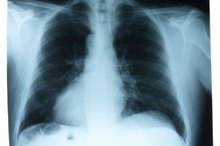Side Effects of Formaldehyde Exposure
Formaldehyde is a widely used chemical in many industries and household products. This compound is used in a variety of products such as paint, adhesives, cosmetics, pharmaceutical products, wood products, disinfectants, antiseptics and tobacco. This compound is also known as methylene oxide or methylaldehyde, and it is a colorless gas with a strong and pungent odor at room temperature. Used mainly as a chemical intermediate, formaldehyde is produced on the industrial scale by the oxidation of methanol. Formaldehyde can have various side effects on humans, based on the level of exposure.
If you are experiencing serious medical symptoms, seek emergency treatment immediately.
Inhalation
According to the U.S. Environmental Protection Agency, the highest levels of airborne formaldehyde have been detected in indoor air, where it is released from various consumer items such as cleaning products, building materials and furnishings 12. The inhalation of air contaminated with formaldehyde may result in respiratory problems such as coughing, bronchitis, chest pains and wheezing. Acute exposure to formaldehyde via inhalation causes irritation in the eyes, throat and nasal cavities. Prolonged or chronic exposure to formaldehyde via inhalation may also lead to labored breathing and lesions in the lungs, potentially causing irreparable damage to the lungs. Professionals who work in constant contact with this compound should wear protective gear to avoid health issues associated with the prolonged handling of formaldehyde 1.
Ingestion
The Effects of Breathing Raw Sewage Fumes
Learn More
Formaldehyde may be present in food artificially through contamination or in nature. Ingestion of formaldehyde may cause corrosion in the gastrointestinal tract. It may also cause ulcers and inflammation in the mouth, esophagus, stomach and intestines. Severe exposure to formaldehyde through ingestion may cause abdominal pain, diarrhea and possible hemorrhage in the stomach or intestines. According to the Health Protection Agency, clinical signs include rapid breathing, yellowish discoloration of the skin, blood in the urine and kidney failure 1.
- Formaldehyde may be present in food artificially through contamination or in nature.
- Severe exposure to formaldehyde through ingestion may cause abdominal pain, diarrhea and possible hemorrhage in the stomach or intestines.
Skin Contact
Formaldehyde exposure to the skin can cause irritation and may burn the skin. According to the Occupational Health and Safety Agency for Healthcare in British Colombia, long-term exposure to formaldehyde can result in skin sensitization and is associated with an increased risk of cancer 13. Individuals with an allergy to formaldehyde are prone to have severe skin irritation; skin rash characterized by redness, cracked and dry skin; and dermatitis that may lead to scarring if left untreated. Workers who are frequently exposed to formaldehyde through the skin commonly develop allergies to the substance. This is because formaldehyde is a skin sensitizer, and once a person is sensitized to formaldehyde, contact with even a small amount of formaldehyde in any form can cause an outbreak of dermatitis.
- Formaldehyde exposure to the skin can cause irritation and may burn the skin.
- According to the Occupational Health and Safety Agency for Healthcare in British Colombia, long-term exposure to formaldehyde can result in skin sensitization and is associated with an increased risk of cancer 1.
Related Articles
References
- Occupational Health and Safety Agency for Healthcare in British Colombia: Formaldehyde
- American Chemistry Council. Why is Formaldehyde Used to Make Vaccines? Washington, DC: American Chemistry Council 2020 https://formaldehyde.americanchemistry.com/ProductsTechnology/Formaldehyde/Why-is-Formaldehyde-Used-to-Make-Vaccines.pdf
- National Cancer Institute. Formaldehyde and Cancer Risk. Reviewed June 10, 2011. Washington, DC: US Department of Health and Human Services, National Cancer Institute at the National Institutes of Health 2020 https://www.cancer.gov/about-cancer/causes-prevention/risk/substances/formaldehyde/formaldehyde-fact-sheet
- World Health Organization International Agency for Research on Cancer. IARC Monographs on the Evaluation of Carcinogenic Risks to Humans. Vol. 88. Formaldehyde, 2-Butoxyethanol and 1-tert-Butoxypropan-2-ol. 2-9 June 2004. Lyon, France: World Health Organization International Agency for Research on Cancer 2006 https://monographs.iarc.fr/wp-content/uploads/2018/06/mono88.pdf
- American Chemistry Council. Why is Formaldehyde Used to Make Vaccines? Washington, DC: American Chemistry Council 2020
- National Cancer Institute. Formaldehyde and Cancer Risk. Reviewed June 10, 2011. Washington, DC: US Department of Health and Human Services, National Cancer Institute at the National Institutes of Health 2020
- Baker RR. The generation of formaldehyde in cigarettes--Overview and recent experiments. Food Chem Toxicol. 2006;44(11):1799-1822. doi:10.1016/j.fct.2006.05.017
- Whitlatch A. Schick S. Thirdhand Smoke at Philip Morris. Nicotine and Tobacco Research. December 2019;21(12):1680–1688. doi:10.1093/ntr/nty153
- New England Journal of Medicine (Letter to the Editor). Hidden Formaldehyde in E-Cigarette Aerosols. N Engl J Med. 2015;372:392-394. doi:10.1056/NEJMc1413069
- Gillmana IG, Kistler KS, Stewart EW, Paolantonioa AR. Effect of variable power levels on the yield of total aerosol mass and formation of aldehydes in e-cigarette aerosols. Regulatory Toxicology and Pharmacology. March 2016;75:58-65. doi:10.1016/j.yrtph.2015.12.019
- World Health Organization International Agency for Research on Cancer. IARC Monographs on the Evaluation of Carcinogenic Risks to Humans. Vol. 88. Formaldehyde, 2-Butoxyethanol and 1-tert-Butoxypropan-2-ol. 2-9 June 2004. Lyon, France: World Health Organization International Agency for Research on Cancer 2006








